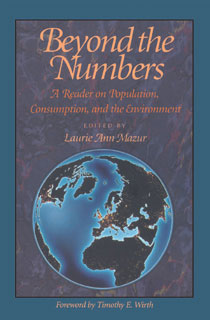
Beyond the Numbers
A Reader on Population, Consumption and the Environment
460 pages
6 x 9

460 pages
6 x 9
Beyond the Numbers presents a thought-provoking series of essays by leading authorities on issues of population and consumption. The essays both define the poles of debate and explore common ground beyond the polarized rhetoric.
Specific chapters consider each of the broad topics addressed at the International Conference on Population and Development held in September 1994 in Cairo, Egypt. The essays are supplemented by sidebars and short articles featuring more-impassioned voices that highlight issues of interest not fully explored in the overviews.
As well as providing a sense of the difficulties involved in dealing with these issues, the essays make clear that constructive action is possible.
Topics covered include:
Acknowledgments
Editor's Addendum
Foreword
Beyond The Numbers: An Introduction And Overview
Section I - Population, Consumption, Development, And The Environment
Seeing The Population Issue Whole
Population, Nature, And The Environment
The Conundrum Of Consumption
Carrying Capacity: The Earth's Bottom Line
Sustainable Development For And By Whom?
Population, Living Standards And Sustainability: An Economic View
Section Ii - Population Growth And Structure
Population By The Numbers: Trends In Population, Growth And Structure
Section Iii - History And Analysis Of Population And Family Planning Programs
The International Family Planning Movement
Sharon L. Camp - The Politics Of U.s. Population Assistance
Populations Policy And Women's Health: Balancing The Scales
Section Iv - Populations Policy, Reproductive Health, And Reproductive Rights
From Family Planning To Reproductive Health
Population Policy Must Encompass More Than Family Planning Services
Seeking Common Ground: Unmet Need And Demographic Goals
Quality: The Key To Success
Abortion And The Global Crisis In Women's Health
Aids: An Agenda For Population Policy
Ethical Issues In Population And Reproductive Health
Law And Reproductive Health
Section V - Population, Gender, And Culture
Investing In Women: The Focus Of The ''˜90s
Women's Rights And Reproductive Choice: Rethinking The Connections
Family And Gender Issues For Populations Policy
Gender And Population Policy
Women's Voices ''˜94
Population Policy And The Clash Of Cultures
Reflections On African-american Resistance To Population Policies And Birth Control
People Of Color And The Discussion Of Population,
Indigenous Peoples, Population, And Sustainability
Section Vi - Population And Religion
American Religious Groups And Population Policy
Population Policies And Christian Ethics
Theo-politics: The Roman Catholic Church And Population Policy
Reflections On Population Policy From The Roman Catholic Tradition
Section Vii - Population Distribution: Urbanization And International Migration
Urbanization Prospects For The 21st Century
International Migration: Causes And Effects
Migration: What Policymakers Can Do
Immigration And Population In The United States: Collision Or Consensus?
Section Viii - Population And National Security
Environmental Change And Violent Conflict
Population And Common Security
Endnotes
Index
It can seem like every news story spells bad news for the environment—from the ongoing clean water crisis in Flint, Michigan to Earth's hottest summer ever recorded. But it's not all doom-and-gloom. With so many dedicated people working on environmental issues, there are also stories of hope. We asked Island Press authors to share good news in their field. Check out the inspiring stories they shared below and if you know of other environmental success stories, share them in the comments.
 Abbie Gascho Landis, author of Immersion:
Abbie Gascho Landis, author of Immersion:
Last summer, mussel biologists and crew worked to relocate over 100,000 mussels, many federally protected, prior to the construction of the I-74 bridge over the Mississippi River. There's also the creation of the Fairmount Water Works' Mussel Hatchery in Pennsylvania, and the proposed listing of the yellow lance mussel as a threatened species under the Endangered Species Act. While it's sad that the mussel needs to be listed, the act of listing it means that its habitat (which is significant!) might benefit from more protections. Better to list a declining species than to ignore it. There's also this video of mussel sexy time, which is awesome, if not newsy.

Laurie Ann Mazur, editor of the Urban Resilience Project and Resilience Matters:
Left behind by the globalized economy, Buffalo New York has lost more than half its population since 1950. By 2005, when the community group People United for Sustainable Housing (PUSH) Buffalo was founded, West Side residents were struggling with unemployment, rampant blight and high energy costs.
At that time, there were an estimated 23,000 vacant homes in Buffalo. PUSH took on a state housing agency that was using vacant buildings to speculate on Wall Street, and got the buildings turned over to the community—with funding to fix them up. Next, PUSH brought together hundreds of community residents to craft a plan for a large, blighted area. The result is a 25-square block Green Development Zone (GDZ) that is now a model of energy efficient, affordable housing. PUSH and its non-profit development company rehabilitate homes in the GDZ, installing efficiency upgrades like insulation and geothermal heating that dramatically lower residents’ utility bills. PUSH also won a New York State grant to build 46 new homes—including a “net zero” house that produces as much energy as it consumes.
The GDZ doubles as a jobs program. Through its construction projects, PUSH has cultivated a growing network of contractors who are committed to hiring locally. And PUSH successfully advocated for New York’s Green Jobs - Green New York program, which seeks to create 35,000 jobs while providing energy upgrades and retrofits for 1 million homes across the state.
Excerpted from an Urban Resilience Project piece in Yes! Magazine by Taj James and Rosa Gonzales

Carlton Reid, author of Bike Boom and Roads Were Not Built For Cars:
There have been a gazillion studies which say how cycling is good for public health, but one new one is a biggie—with a sample size of more than 250,000 Brits—and led to global media coverage. The Scottish study was published in the British Medical Journal and, staggeringly, it said cycling to work lowers the risk of dying by 40 percent. If medical science created a pill with that sort of impact it would be quickly bigger than Viagra! Cancer is a huge worry for the Western world, yet cycling to work halves your chance from dying from it. Amazing, really.
 Michael S. Carolan, author of No One Eats Alone:
Michael S. Carolan, author of No One Eats Alone:
If you go back to the first 100 years of this nation, our food system was built on people sharing seeds. That was, in fact, the *only* way new seeds were acquired—that and saving seeds from the prior year's harvest. Seed saving and sharing is not only becoming a lost art, it is also illegal in certain instances.
For example, take the case, from 2014, when the Pennsylvania Department of Agriculture informed a seed library in its state that they were in violation of a 2004 state law—the Pennsylvania Seed Act of 2004. The seed library, its officials were told, fell under the definition of a “seed distributor,” which meant they needed to start acting like one. That required that they meet stringent labeling requirements. The labels, which need to be in English, must clearly state the name of the species or commonly accepted name of kind of plant. If it is a hybrid plant, the label must explain something about whether the seed has been treated. Lastly, labels must include the name and address of the seed-sharing entity. As a seed distributor, the library was also told they must conduct germination and purity analyses.
On a more encouraging note: In September 2016, the Seed Exchange Democracy Act (Assembly Bill 1810) was signed into law in California. The bill amends the “seed law” chapter of the state’s Food and Agricultural Code thus exempting seed libraries from burdensome testing and labeling requirements.
The Sustainable Economic Law Center offers a toolkit of resources to help concerned citizens make the Seed Exchange Democracy Act a reality in their own state. It includes sample legislation, local resolutions, letters of support, and more.

Joy Zedler, co-author of Foundations of Restoration Ecology:
Restoration ecology and our book on its foundations support new pathways for restoring watersheds to protect wetlands. After decades of teaching conservation and restoration of ecosystems, I'm using the wisdom captured in our book to practice what I've been preaching. I'm one of the fortunate few who have wetlands in our back yards. I live near intact natural ecosystems among citizens who tax themselves so our township can purchase development rights and create conservation easements. The challenge is to extend voluntary approaches upstream to achieve watershed restoration goals and protect downstream wetland gems. The solution won't be top-down governance in this state—or in this country at the present time—but the solution could be bottom-up watershed-care based on strong science and wetland ethics.
Donald A. Falk, co-author of Foundations of Restoration Ecology
To me the really big and encouraging news is that ecosystem restoration is understood increasingly as a central component of global efforts to reverse anthropogenic climate change. This means that the streams of ecological restoration, ecosystem and biodiversity protection, and climate action are fusing, creating a powerful incentive to both protect and restore ecosystems which are absorbing at least a quarter of all GHG emissions annually (for an essay on this, see Ecosystems are critical to solving the global climate crisis).
